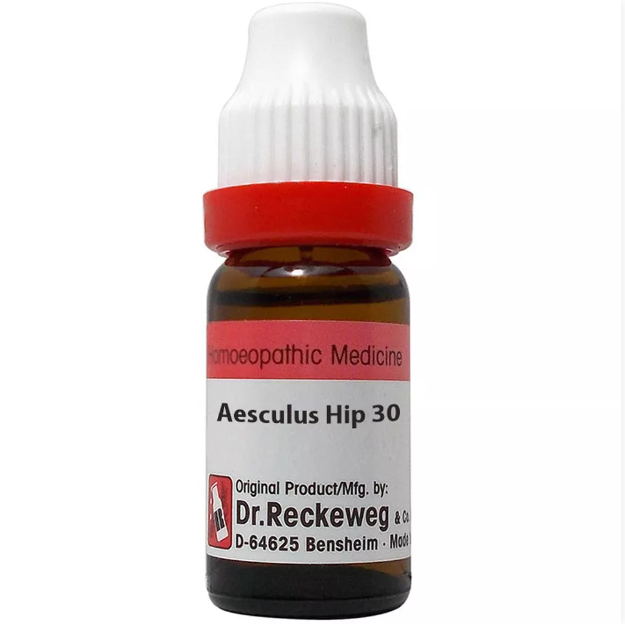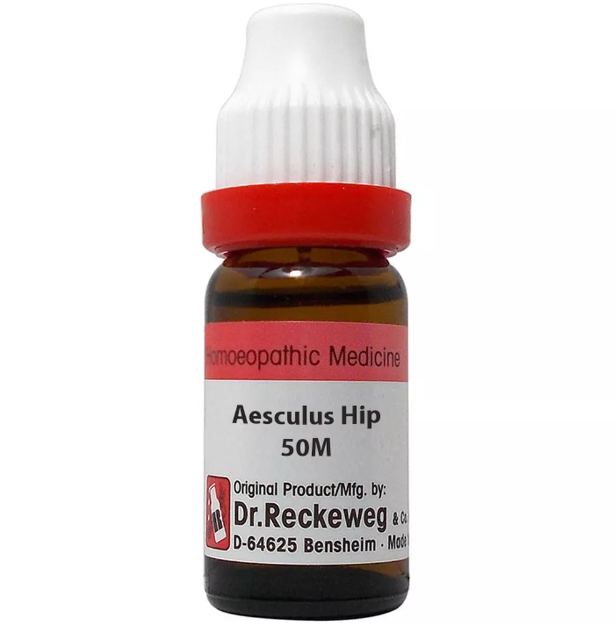AESCULUS HIPPOCASTANUM Q, 6C, 12C, 30C, 200C, 1M, 10M USES AND SYMPTOMS
 This remedy primarily affects the lower bowel, causing swollen hemorrhoidal veins, accompanied by a distinctive backache and an absence of actual constipation. Although there is intense pain, bleeding is minimal. General venous stagnation is evident, with varicose veins appearing in a purple hue; overall, bodily functions slow down, including digestion, heart rate, and bowel movements. The liver and portal system experience torpor and congestion, leading to constipation. The severe backache makes the individual unsuitable for work. Pervasive flying pains occur throughout the body, along with a sense of fullness in various areas and dry, swollen mucous membranes. Hemorrhoidal conditions are also noted in the throat.
This remedy primarily affects the lower bowel, causing swollen hemorrhoidal veins, accompanied by a distinctive backache and an absence of actual constipation. Although there is intense pain, bleeding is minimal. General venous stagnation is evident, with varicose veins appearing in a purple hue; overall, bodily functions slow down, including digestion, heart rate, and bowel movements. The liver and portal system experience torpor and congestion, leading to constipation. The severe backache makes the individual unsuitable for work. Pervasive flying pains occur throughout the body, along with a sense of fullness in various areas and dry, swollen mucous membranes. Hemorrhoidal conditions are also noted in the throat.
Head: Feelings of depression and irritability prevail. The head feels dull, confused, and achy, akin to a cold. Forehead pressure, accompanied by nausea and subsequent stitches in the right hypochondrium, is experienced. Pain extends from the occiput to the frontal region, with a bruised sensation on the scalp, particularly worse in the morning. Neuralgic stitches from right to left across the forehead are followed by flying pains in the epigastrium. Vertigo is present when sitting and walking.
Eyes: The eyes feel heavy and hot, with lachrymation and enlarged blood vessels. Soreness in the eyeballs is also noted.
Nose: Dryness is observed, and inspired air feels cold, causing sensitivity in nasal passages. Coryza and sneezing occur, along with pressure at the root of the nose. Membrane distension over turbinate bones is related to hepatic disorders.
Mouth: A scalded sensation, metallic taste, and salivation are reported. The tongue is thickly coated, giving a scalded feeling.
Throat: The throat is hot, dry, and raw, with stitching pains radiating to the ears during swallowing. Follicular pharyngitis linked to hepatic congestion is present. Veins in the pharynx are distended and tortuous. The throat is sensitive to inspired air, feeling excoriated and constricted, burning like fire on swallowing in the afternoon. Early stages of atrophic pharyngitis are seen in dried up, bilious subjects. Hawking of ropy mucus with a sweetish taste is noted. Laryngitis and cough are associated with liver disorders.
Stomach: A sense of weight, as if a stone is present, accompanies gnawing and aching pains, peaking about three hours after meals.
Abdomen: Tenderness and fullness in the liver region are observed. Dull aching occurs in the liver region and epigastrium. Pain is felt in the umbilical region. Jaundice is accompanied by throbbing in the hypogastrium and pelvis.
Rectum: Dryness and aching are experienced, with a feeling of fullness akin to small sticks. The anus is raw and sore, with severe pain after stool, leading to prolapse. Hemorrhoids, with sharp shooting pains up the back, are both blind and bleeding, worsening during climacteric. Stools are large, hard, and dry. The mucous membrane appears swollen, obstructing passage. Irritation caused by ascarides is relieved, aiding in their expulsion. Burning in the anus, along with chills up and down the back, is present.
Urinary: Urination is frequent, scanty, dark, muddy, and hot. Pain in the kidneys, especially on the left side and ureter, is reported.
Male: Prostatic fluid discharge during stool (prostatorrhea) is noted.
Female: Constant throbbing is felt behind the symphysis pubis. Leucorrhea, with back lameness across the sacro-iliac articulation, is dark yellow, sticky, and corrosive, worsening after menses.
Heart: A constricted feeling is reported. The heart’s action is full and heavy, with pulsations felt throughout the body. A sensation of heat in the chest and pain around the heart region is noted in individuals with hemorrhoidal conditions.
Back: Lameness in the neck, aching between the shoulder blades (cervical spondylosis), and weakness in the region of the spine are experienced. Backache affects the sacrum and hips, worsening during walking or stooping. When walking, the feet turn under, and the soles feel sore, tired, and swollen. Hands and feet swell and become red after washing, feeling full.
Extremities: Aching and soreness are felt in the limbs, particularly in the left acromion process radiating to the arms; finger tips may become numb.
Fever: Chills occur at 4 p.m., running up and down the back. Fever is present from 7 p.m. to 12 a.m., with hot and dry skin. Profuse and hot sweating accompanies fever.
Modalities: Symptoms worsen in the morning upon awakening, with any motion or walking, moving bowels, after eating, in the afternoon, and while standing. Improvement is observed in cool, open air.
Relationship: Aesculus glabra-Ohio buckeye: Specifically for proctitis with very painful, dark purple, external hemorrhoids, constipation, vertigo, and portal congestion. Speech may become thick, with tickling in the throat, impaired vision, and paresis. Phytolacca decandra (dry throat, more common in acute cases). Negundium americanum- Boxelder (rectal engorgements and piles with severe pain; recommended dosage of ten drops of tincture every two hours).
Comparison with Aloe, Coll., Nux-v., Sulph. Dosage: Tincture up to the third potency.
SYMPTOMS OF AESCULUS HIPPOCASTANUM
 General Characteristics:
General Characteristics:
- Marked action on the lower bowel.
- Engorged hemorrhoidal veins, with severe backache.
- Absence of actual constipation, but with intense pain and minimal bleeding.
- General venous stasis, with varicose veins in a purple color.
- Slowdown of bodily functions, including digestion, heart, and bowels.
- Torpor and congestion of the liver and portal system, leading to constipation.
Head:
- Depression and irritability.
- Dull, confused head, akin to a cold.
- Forehead pressure, nausea, followed by stitches in the right hypochondrium.
- Pain from occiput to frontal region, with a bruised sensation on the scalp, worse in the morning.
- Neuralgic stitches in the forehead, followed by flying pains in the epigastrium.
- Vertigo when sitting and walking.
Eyes:
- Heavy and hot eyes, with lachrymation and enlarged blood vessels.
- Sore eyeballs.
Nose:
- Dry nose; inspired air feels cold, nasal passages sensitive.
- Coryza and sneezing.
- Pressure at the root of the nose.
- Membrane over turbinate bones distended and boggy, related to hepatic disorders.
Mouth:
- Scalded feeling in the mouth.
- Metallic taste.
- Salivation.
- Thickly coated tongue, feeling scalded.
Throat:
- Hot, dry, raw throat.
- Stitching pains radiating to the ears during swallowing.
- Follicular pharyngitis linked to hepatic congestion.
- Distended and tortuous veins in the pharynx.
- Throat sensitive to inspired air, feels excoriated and constricted, burns like fire on swallowing in the afternoon.
- Hawking of ropy mucus with a sweetish taste.
- Laryngitis; cough depending on liver disorders.
Stomach:
- Weight in the stomach, as of a stone, with gnawing, aching pains.
- Maximum discomfort about three hours after meals.
Abdomen:
- Tenderness and fullness in the liver region.
- Dull aching in the liver region and epigastrium.
- Pain in the umbilical region.
- Throbbing in the hypogastrium and pelvis associated with jaundice.
Rectum:
- Dry, aching rectum.
- Feeling full of small sticks.
- Raw, sore anus.
- Severe pain after stool, with prolapse.
- Hemorrhoids with sharp shooting pains up the back, blind and bleeding; worse during climacteric.
- Large, hard, dry stools.
- Swollen mucous membrane obstructs the passage.
- Irritation caused by ascarides, aiding in their expulsion.
- Burning in the anus with chills up and down the back.
Urinary:
- Frequent, scanty, dark, muddy, hot urine.
- Pain in kidneys, especially on the left side and ureter.
Male:
- Discharge of prostatic fluid during stool (prostatorrhea).
Female:
- Constant throbbing behind symphysis pubis.
- Leucorrhea with back lameness; dark yellow, sticky, corroding; worse after menses.
Heart:
- Constricted feeling.
- Full and heavy heart’s action, with pulsations felt all over.
- Sensation of heat in the chest; pain around the heart region in hemorrhoidal subjects.
Back:
- Lameness in the neck.
- Aching between the shoulder blades (cervical spondylosis).
- Weakness in the region of the spine.
- Backache affecting sacrum and hips; worse walking or stooping.
- Feet turn under while walking.
- Soles feel sore, tired, and swollen.
- Swelling and redness of hands and feet after washing, feeling full.
Extremities:
- Aching and soreness in the limbs, particularly in the left acromion process radiating to the arms.
- Numbness in fingertips.
Fever:
- Chill at 4 p.m.
- Chills running up and down the back.
- Evening fever, with hot and dry skin.
- Profuse and hot sweating with fever.
Modalities:
- Worse in the morning on awakening, from any motion, walking, moving bowels, after eating, in the afternoon, and while standing.
- Better in cool open air.
selection of the potency
Individualization:
- Homeopathy is based on the principle of treating the individual, not just the disease. The unique symptoms and characteristics of the person are crucial in determining the most suitable potency.
Intensity of Symptoms:
- The intensity of the symptoms guides the choice of potency. If the symptoms are intense and acute, a lower potency (e.g., 6C, 30C) might be considered. For chronic conditions with less intensity, higher potencies (e.g., 200C, 1M) may be appropriate.
Sensitivity of the Patient:
- Some individuals are more sensitive to homeopathic remedies, while others may require higher potencies. The practitioner considers the patient’s sensitivity when selecting the potency.
Acute vs. Chronic Conditions:
- Lower potencies are often used for acute conditions, while higher potencies may be considered for chronic or long-standing issues.
Previous Response to Potencies:
- The patient’s response to previous homeopathic treatments helps guide the choice of potency. If a particular potency has been effective in the past, it may be repeated or adjusted as needed.
Vital Force and Susceptibility:
- Homeopathy views illness as a disturbance in the vital force. The practitioner assesses the patient’s overall vitality and susceptibility to determine the appropriate potency.
Aggravation or Amelioration:
- The direction of the symptom response (aggravation or amelioration) after taking a remedy can influence the choice of potency.
Miasmatic Considerations:
- In classical homeopathy, the concept of miasms (inherited disease tendencies) is considered. The practitioner take this into account when selecting the potency.
Practitioner Experience:
- The experience and preference of the homeopathic practitioner play a role. Some practitioners may have success with certain potencies based on their clinical experience.
SAFETY INFORMATION
- Do not exceed the recommended dose by physician
- Keep out of the reach of children
- Store in a cool dry place away from direct sunlight
- Maintain half an hour gap between food/drink/any other medicines and homoeopathic medicine
- Avoid any strong smell in the mouth while taking medicine e.g. camphor, garlic, onion, coffee, hing
Medicine images use for reference only selection of homeopathic medicine depends on the individual’s specific symptoms and overall constitution. Moreover, homeopathy is a holistic system of medicine that treats the individual as a whole. In addition to addressing the physical symptoms, it takes into account the emotional and mental state of the person. Consequently, it’s crucial to consult with a qualified homeopathic practitioner for personalized treatment.
The information provided on this website is intended solely for educational purposes. Always seek the advice of your physician or other qualified health provider.
